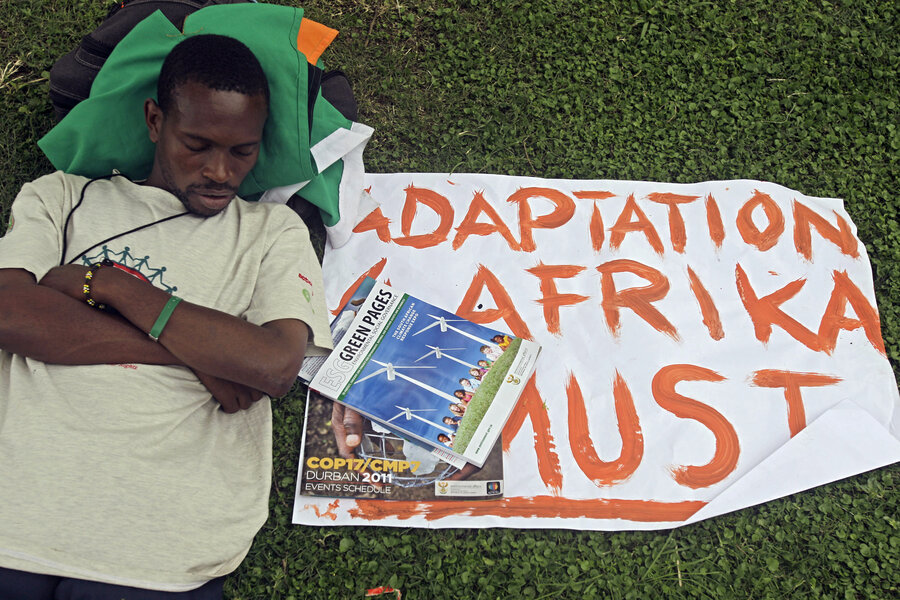Unusual heat waves in Africa will soon be the norm, study says
Loading...
Unusual African heat waves could become usual in as little as 20 years, according to a paper published Wednesday in the journal Environmental Research Letters.
With its geographic location between the Tropic of Cancer and the Tropic of Capricorn, Africa already boasts some of the hottest annual temperature averages in the world. But between 2004 and 2015, Africa has experienced unusual temperature hikes – described as record-breaking, especially great in magnitude and length for a given region – at least once every two years.
These heat waves will likely require a shift in the type and location of crops grown in Africa, say researchers.
After running climate models through the year 2075, researchers from the Institute for Environment Protection and Research (ISPRA), the University of Catania, and the Center for International Climate and Environmental Research (CICERO) suggest that extreme heat waves will likely occur four times every year by the end of the century.
"An unusual heat wave in our study is an event that has never happened before," Jana Sillmann, a geo-ecologist at CICERO in Oslo and co-author of the paper, tells The Christian Science Monitor. "So we are basically looking at a record-breaking event in current temperature observations of years 1979-2016."
The heat wave between November 2015 and January 2016 had a much higher magnitude than previous ones, Dr. Sillmann says. By 2040, however, the team's climate models show that "such an unusual event will become regular – meaning it can occur every year, and not just once in 38 years – in climate change scenarios."
Using a metric called the Heat Wave Magnitude Index daily (HWMId), the authors assessed heat waves by taking into account the severity of the temperature and the number of days it persisted. Whereas other heat wave indicators typically take into account only one aspect of a heat wave, the HWMId assesses heat waves as an entire event, allowing comparison between countries and over time.
But all heat waves aren't created equal: Africa's future heat waves will likely be hotter than its heat waves today. Even a small warming of the mean annual temperature can create "a much larger increase in very extreme temperatures," Sillman explains. Thus unusual heat waves will be hot, even by Africa's standards.
"By the end of the century, heat waves that are unusual under current climate will become very common along with rising global mean temperatures and could occur with a frequency of every season in any country in Africa," the authors write. "Given that adaptation and resilience measures presently undertaken in most African countries are already reaching their limits under current climate, the projected increase in extreme heat waves in the coming decades can result in humanitarian crises of unknown dimensions… Longer, hotter and more frequent heat waves are very likely to have a strong impact on mortality, occurrence of wild fires and crop failure."
Although a recent study actually found a positive correlation between carbon dioxide levels in the Earth's atmosphere and enhanced plant growth, the majority of studies on climate data and crop viability have not been encouraging.
According to a 2015 report by the CGIAR Research Program on Climate Change, Agriculture and Food Security (CCAFS), maize productivity will decrease by 5-10 percent and rice productivity will decrease by 2-5 percent for every degree of warming in the 21st century if no adaptation measures are taken.
"Adaptation can counter some of these negative impacts, but it is critical that measures are implemented early, as impacts are already taking place in a number of cases or are likely to be observed in the next 10-20 years," explain researchers Julien Ramirez-Villegas and Philip Thornton, who authored the 2015 report. Some adaptation measures include breeding climate-smart varieties, site-specific agriculture, and shifts in diet.
And unless countries like Mali, Senegal, Burkina Faso, and Niger implement adaptation strategies, crops like maize, common beans, finger millet, and bananas may no longer survive in these countries. For these crops in particular, suitable range is projected to decrease by 30 to 50 percent across the continent.
Although future warming is already set in motion, Sillman says inaction is not an option. Progress will be gradual, but "there is not an option to wait and sit it out when we continue to burn fossil fuels at the rate we are doing now, because temperatures will rise continuously – as if you put more and more blankets over you," she says.
"If we take action now by reducing greenhouse gas emissions, we can prevent the world from heating up even more and still have the option to take adaptation measures to cope with the changes we have already caused."








